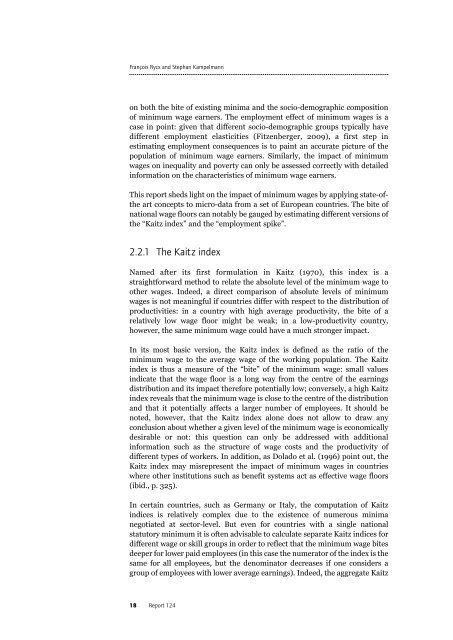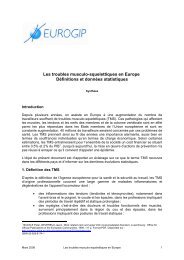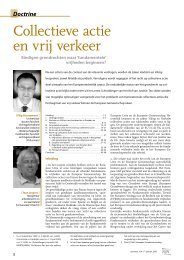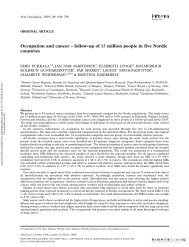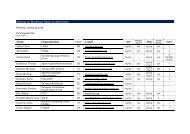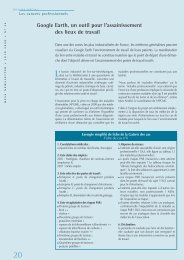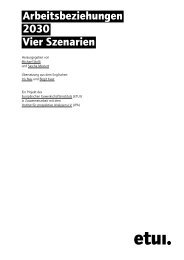Who earns minimum wages in Europe - European Trade Union ...
Who earns minimum wages in Europe - European Trade Union ...
Who earns minimum wages in Europe - European Trade Union ...
Create successful ePaper yourself
Turn your PDF publications into a flip-book with our unique Google optimized e-Paper software.
François Rycx and Stephan Kampelmann<br />
on both the bite of exist<strong>in</strong>g m<strong>in</strong>ima and the socio-demographic composition<br />
of <strong>m<strong>in</strong>imum</strong> wage earners. The employment effect of <strong>m<strong>in</strong>imum</strong> <strong>wages</strong> is a<br />
case <strong>in</strong> po<strong>in</strong>t: given that different socio-demographic groups typically have<br />
different employment elasticities (Fitzenberger, 2009), a first step <strong>in</strong><br />
estimat<strong>in</strong>g employment consequences is to pa<strong>in</strong>t an accurate picture of the<br />
population of <strong>m<strong>in</strong>imum</strong> wage earners. Similarly, the impact of <strong>m<strong>in</strong>imum</strong><br />
<strong>wages</strong> on <strong>in</strong>equality and poverty can only be assessed correctly with detailed<br />
<strong>in</strong>formation on the characteristics of <strong>m<strong>in</strong>imum</strong> wage earners.<br />
This report sheds light on the impact of <strong>m<strong>in</strong>imum</strong> <strong>wages</strong> by apply<strong>in</strong>g state-ofthe<br />
art concepts to micro-data from a set of <strong>Europe</strong>an countries. The bite of<br />
national wage floors can notably be gauged by estimat<strong>in</strong>g different versions of<br />
the “Kaitz <strong>in</strong>dex” and the “employment spike”.<br />
2.2.1 The Kaitz <strong>in</strong>dex<br />
Named after its first formulation <strong>in</strong> Kaitz (1970), this <strong>in</strong>dex is a<br />
straightforward method to relate the absolute level of the <strong>m<strong>in</strong>imum</strong> wage to<br />
other <strong>wages</strong>. Indeed, a direct comparison of absolute levels of <strong>m<strong>in</strong>imum</strong><br />
<strong>wages</strong> is not mean<strong>in</strong>gful if countries differ with respect to the distribution of<br />
productivities: <strong>in</strong> a country with high average productivity, the bite of a<br />
relatively low wage floor might be weak; <strong>in</strong> a low-productivity country,<br />
however, the same <strong>m<strong>in</strong>imum</strong> wage could have a much stronger impact.<br />
In its most basic version, the Kaitz <strong>in</strong>dex is def<strong>in</strong>ed as the ratio of the<br />
<strong>m<strong>in</strong>imum</strong> wage to the average wage of the work<strong>in</strong>g population. The Kaitz<br />
<strong>in</strong>dex is thus a measure of the “bite” of the <strong>m<strong>in</strong>imum</strong> wage: small values<br />
<strong>in</strong>dicate that the wage floor is a long way from the centre of the earn<strong>in</strong>gs<br />
distribution and its impact therefore potentially low; conversely, a high Kaitz<br />
<strong>in</strong>dex reveals that the <strong>m<strong>in</strong>imum</strong> wage is close to the centre of the distribution<br />
and that it potentially affects a larger number of employees. It should be<br />
noted, however, that the Kaitz <strong>in</strong>dex alone does not allow to draw any<br />
conclusion about whether a given level of the <strong>m<strong>in</strong>imum</strong> wage is economically<br />
desirable or not: this question can only be addressed with additional<br />
<strong>in</strong>formation such as the structure of wage costs and the productivity of<br />
different types of workers. In addition, as Dolado et al. (1996) po<strong>in</strong>t out, the<br />
Kaitz <strong>in</strong>dex may misrepresent the impact of <strong>m<strong>in</strong>imum</strong> <strong>wages</strong> <strong>in</strong> countries<br />
where other <strong>in</strong>stitutions such as benefit systems act as effective wage floors<br />
(ibid., p. 325).<br />
In certa<strong>in</strong> countries, such as Germany or Italy, the computation of Kaitz<br />
<strong>in</strong>dices is relatively complex due to the existence of numerous m<strong>in</strong>ima<br />
negotiated at sector-level. But even for countries with a s<strong>in</strong>gle national<br />
statutory <strong>m<strong>in</strong>imum</strong> it is often advisable to calculate separate Kaitz <strong>in</strong>dices for<br />
different wage or skill groups <strong>in</strong> order to reflect that the <strong>m<strong>in</strong>imum</strong> wage bites<br />
deeper for lower paid employees (<strong>in</strong> this case the numerator of the <strong>in</strong>dex is the<br />
same for all employees, but the denom<strong>in</strong>ator decreases if one considers a<br />
group of employees with lower average earn<strong>in</strong>gs). Indeed, the aggregate Kaitz<br />
18 Report 124


